Consumer Behavior and Travel Decisions of Chinese Tourists
VerifiedAdded on 2023/01/11
|14
|3620
|99
Case Study
AI Summary
This case study delves into the consumer behavior and travel decision-making processes of Chinese tourists, focusing on both the outbound and inbound tourism markets concerning Australia. The analysis begins with an overview of the Chinese outbound tourist market, highlighting its growth and the evolving preferences of Chinese travelers, segmented by various consumer profiles such as value-seeking sightseers, shoppers, and individualists. The study then examines the Chinese inbound tourist market to Australia, emphasizing its significance to the Australian economy and the factors driving Chinese tourists to choose Australia as a destination, including government initiatives and the appeal of the Australian climate and lifestyle. The report further investigates the impact of group and interpersonal influences, such as family, friends, and social media, on Chinese tourists' travel decisions, as well as the role of situational factors like spending habits and destination image. Finally, the case study explores the specific travel decisions made by Chinese tourists when planning a holiday to Australia, including the criteria and motivations behind their destination choices. The analysis includes references to academic journals and reports, providing a comprehensive understanding of this important consumer segment.
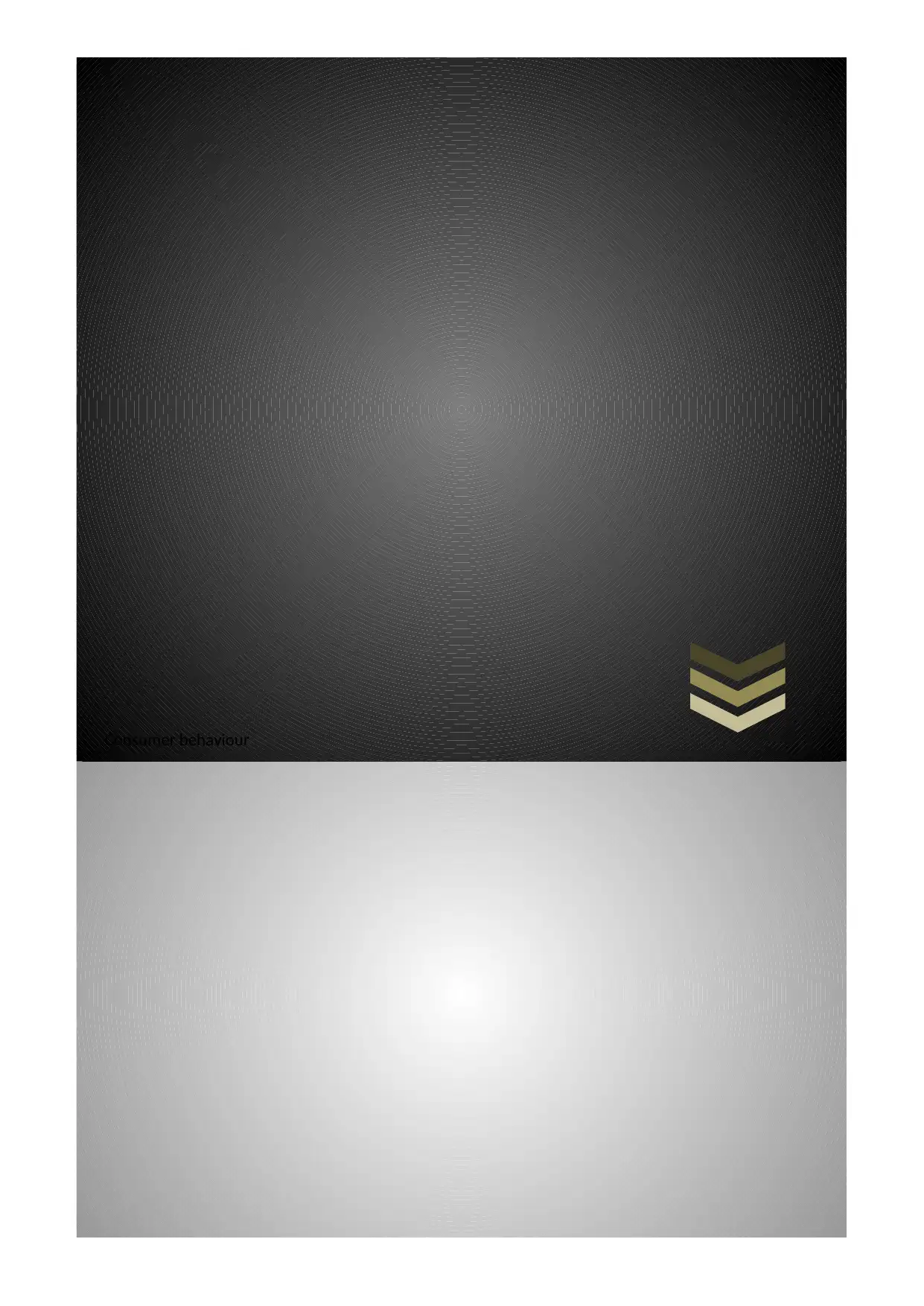
Consumer behaviour
Paraphrase This Document
Need a fresh take? Get an instant paraphrase of this document with our AI Paraphraser
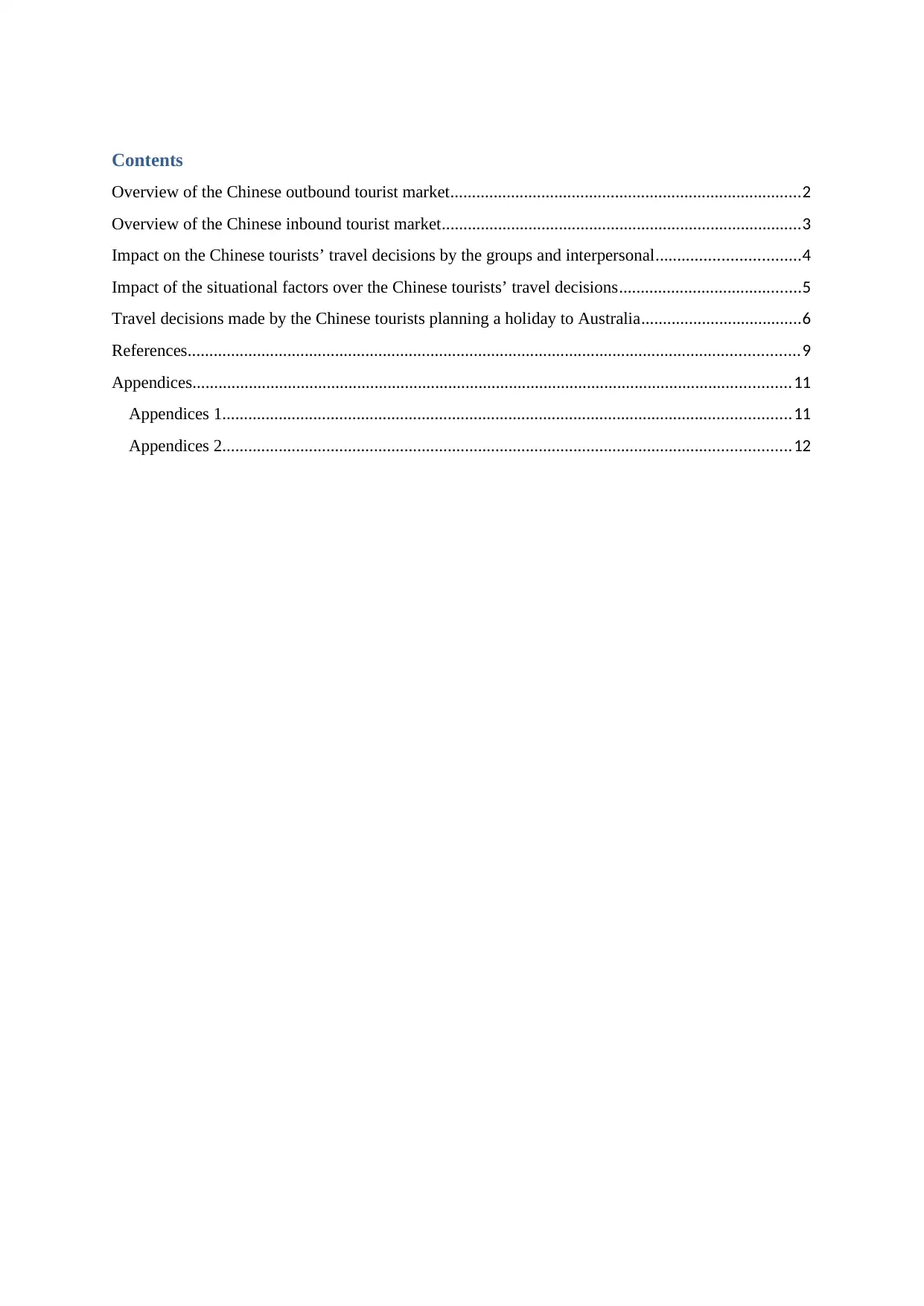
Contents
Overview of the Chinese outbound tourist market.................................................................................2
Overview of the Chinese inbound tourist market...................................................................................3
Impact on the Chinese tourists’ travel decisions by the groups and interpersonal.................................4
Impact of the situational factors over the Chinese tourists’ travel decisions..........................................5
Travel decisions made by the Chinese tourists planning a holiday to Australia.....................................6
References.............................................................................................................................................9
Appendices..........................................................................................................................................11
Appendices 1...................................................................................................................................11
Appendices 2...................................................................................................................................12
Overview of the Chinese outbound tourist market.................................................................................2
Overview of the Chinese inbound tourist market...................................................................................3
Impact on the Chinese tourists’ travel decisions by the groups and interpersonal.................................4
Impact of the situational factors over the Chinese tourists’ travel decisions..........................................5
Travel decisions made by the Chinese tourists planning a holiday to Australia.....................................6
References.............................................................................................................................................9
Appendices..........................................................................................................................................11
Appendices 1...................................................................................................................................11
Appendices 2...................................................................................................................................12
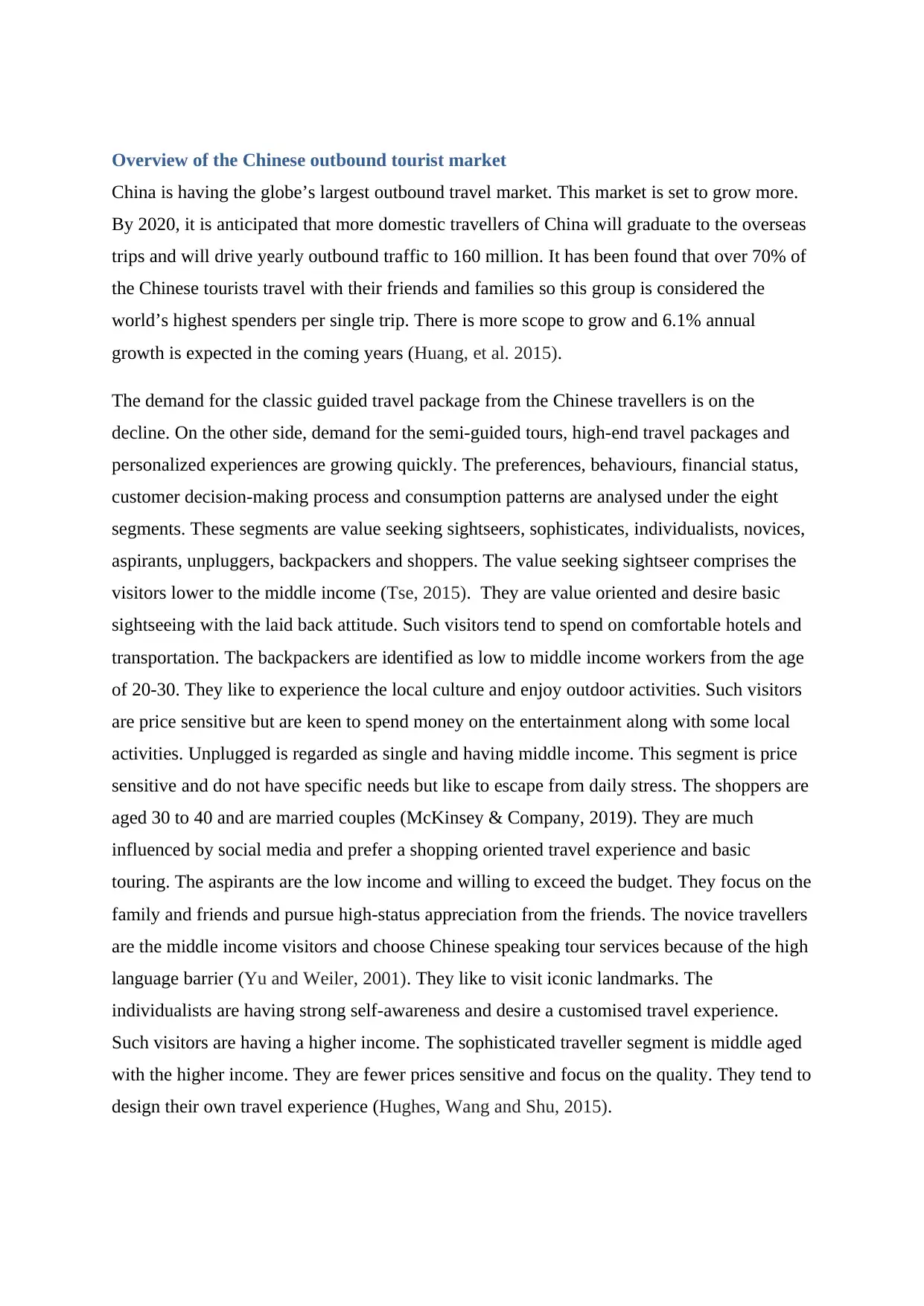
Overview of the Chinese outbound tourist market
China is having the globe’s largest outbound travel market. This market is set to grow more.
By 2020, it is anticipated that more domestic travellers of China will graduate to the overseas
trips and will drive yearly outbound traffic to 160 million. It has been found that over 70% of
the Chinese tourists travel with their friends and families so this group is considered the
world’s highest spenders per single trip. There is more scope to grow and 6.1% annual
growth is expected in the coming years (Huang, et al. 2015).
The demand for the classic guided travel package from the Chinese travellers is on the
decline. On the other side, demand for the semi-guided tours, high-end travel packages and
personalized experiences are growing quickly. The preferences, behaviours, financial status,
customer decision-making process and consumption patterns are analysed under the eight
segments. These segments are value seeking sightseers, sophisticates, individualists, novices,
aspirants, unpluggers, backpackers and shoppers. The value seeking sightseer comprises the
visitors lower to the middle income (Tse, 2015). They are value oriented and desire basic
sightseeing with the laid back attitude. Such visitors tend to spend on comfortable hotels and
transportation. The backpackers are identified as low to middle income workers from the age
of 20-30. They like to experience the local culture and enjoy outdoor activities. Such visitors
are price sensitive but are keen to spend money on the entertainment along with some local
activities. Unplugged is regarded as single and having middle income. This segment is price
sensitive and do not have specific needs but like to escape from daily stress. The shoppers are
aged 30 to 40 and are married couples (McKinsey & Company, 2019). They are much
influenced by social media and prefer a shopping oriented travel experience and basic
touring. The aspirants are the low income and willing to exceed the budget. They focus on the
family and friends and pursue high-status appreciation from the friends. The novice travellers
are the middle income visitors and choose Chinese speaking tour services because of the high
language barrier (Yu and Weiler, 2001). They like to visit iconic landmarks. The
individualists are having strong self-awareness and desire a customised travel experience.
Such visitors are having a higher income. The sophisticated traveller segment is middle aged
with the higher income. They are fewer prices sensitive and focus on the quality. They tend to
design their own travel experience (Hughes, Wang and Shu, 2015).
China is having the globe’s largest outbound travel market. This market is set to grow more.
By 2020, it is anticipated that more domestic travellers of China will graduate to the overseas
trips and will drive yearly outbound traffic to 160 million. It has been found that over 70% of
the Chinese tourists travel with their friends and families so this group is considered the
world’s highest spenders per single trip. There is more scope to grow and 6.1% annual
growth is expected in the coming years (Huang, et al. 2015).
The demand for the classic guided travel package from the Chinese travellers is on the
decline. On the other side, demand for the semi-guided tours, high-end travel packages and
personalized experiences are growing quickly. The preferences, behaviours, financial status,
customer decision-making process and consumption patterns are analysed under the eight
segments. These segments are value seeking sightseers, sophisticates, individualists, novices,
aspirants, unpluggers, backpackers and shoppers. The value seeking sightseer comprises the
visitors lower to the middle income (Tse, 2015). They are value oriented and desire basic
sightseeing with the laid back attitude. Such visitors tend to spend on comfortable hotels and
transportation. The backpackers are identified as low to middle income workers from the age
of 20-30. They like to experience the local culture and enjoy outdoor activities. Such visitors
are price sensitive but are keen to spend money on the entertainment along with some local
activities. Unplugged is regarded as single and having middle income. This segment is price
sensitive and do not have specific needs but like to escape from daily stress. The shoppers are
aged 30 to 40 and are married couples (McKinsey & Company, 2019). They are much
influenced by social media and prefer a shopping oriented travel experience and basic
touring. The aspirants are the low income and willing to exceed the budget. They focus on the
family and friends and pursue high-status appreciation from the friends. The novice travellers
are the middle income visitors and choose Chinese speaking tour services because of the high
language barrier (Yu and Weiler, 2001). They like to visit iconic landmarks. The
individualists are having strong self-awareness and desire a customised travel experience.
Such visitors are having a higher income. The sophisticated traveller segment is middle aged
with the higher income. They are fewer prices sensitive and focus on the quality. They tend to
design their own travel experience (Hughes, Wang and Shu, 2015).
⊘ This is a preview!⊘
Do you want full access?
Subscribe today to unlock all pages.

Trusted by 1+ million students worldwide
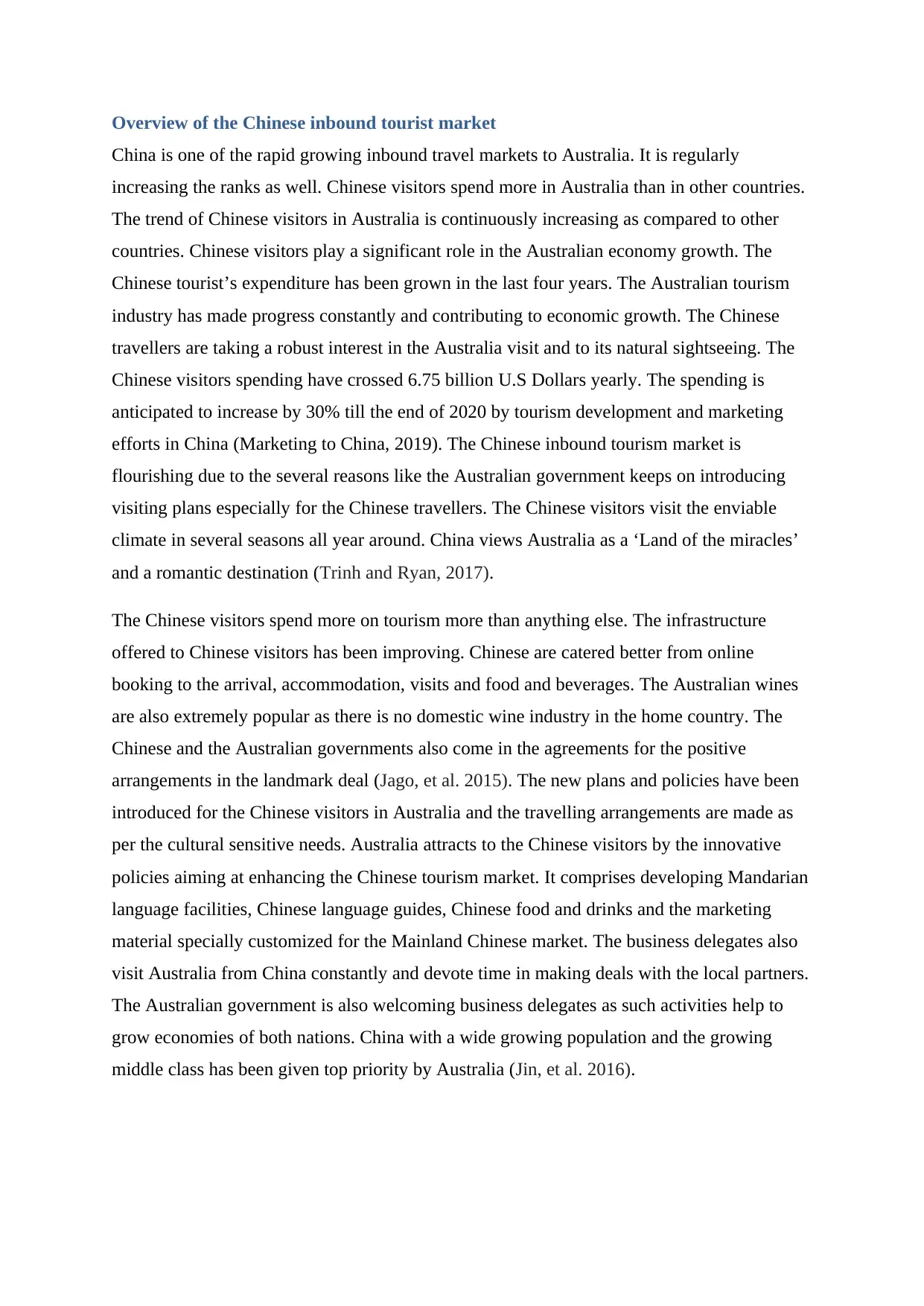
Overview of the Chinese inbound tourist market
China is one of the rapid growing inbound travel markets to Australia. It is regularly
increasing the ranks as well. Chinese visitors spend more in Australia than in other countries.
The trend of Chinese visitors in Australia is continuously increasing as compared to other
countries. Chinese visitors play a significant role in the Australian economy growth. The
Chinese tourist’s expenditure has been grown in the last four years. The Australian tourism
industry has made progress constantly and contributing to economic growth. The Chinese
travellers are taking a robust interest in the Australia visit and to its natural sightseeing. The
Chinese visitors spending have crossed 6.75 billion U.S Dollars yearly. The spending is
anticipated to increase by 30% till the end of 2020 by tourism development and marketing
efforts in China (Marketing to China, 2019). The Chinese inbound tourism market is
flourishing due to the several reasons like the Australian government keeps on introducing
visiting plans especially for the Chinese travellers. The Chinese visitors visit the enviable
climate in several seasons all year around. China views Australia as a ‘Land of the miracles’
and a romantic destination (Trinh and Ryan, 2017).
The Chinese visitors spend more on tourism more than anything else. The infrastructure
offered to Chinese visitors has been improving. Chinese are catered better from online
booking to the arrival, accommodation, visits and food and beverages. The Australian wines
are also extremely popular as there is no domestic wine industry in the home country. The
Chinese and the Australian governments also come in the agreements for the positive
arrangements in the landmark deal (Jago, et al. 2015). The new plans and policies have been
introduced for the Chinese visitors in Australia and the travelling arrangements are made as
per the cultural sensitive needs. Australia attracts to the Chinese visitors by the innovative
policies aiming at enhancing the Chinese tourism market. It comprises developing Mandarian
language facilities, Chinese language guides, Chinese food and drinks and the marketing
material specially customized for the Mainland Chinese market. The business delegates also
visit Australia from China constantly and devote time in making deals with the local partners.
The Australian government is also welcoming business delegates as such activities help to
grow economies of both nations. China with a wide growing population and the growing
middle class has been given top priority by Australia (Jin, et al. 2016).
China is one of the rapid growing inbound travel markets to Australia. It is regularly
increasing the ranks as well. Chinese visitors spend more in Australia than in other countries.
The trend of Chinese visitors in Australia is continuously increasing as compared to other
countries. Chinese visitors play a significant role in the Australian economy growth. The
Chinese tourist’s expenditure has been grown in the last four years. The Australian tourism
industry has made progress constantly and contributing to economic growth. The Chinese
travellers are taking a robust interest in the Australia visit and to its natural sightseeing. The
Chinese visitors spending have crossed 6.75 billion U.S Dollars yearly. The spending is
anticipated to increase by 30% till the end of 2020 by tourism development and marketing
efforts in China (Marketing to China, 2019). The Chinese inbound tourism market is
flourishing due to the several reasons like the Australian government keeps on introducing
visiting plans especially for the Chinese travellers. The Chinese visitors visit the enviable
climate in several seasons all year around. China views Australia as a ‘Land of the miracles’
and a romantic destination (Trinh and Ryan, 2017).
The Chinese visitors spend more on tourism more than anything else. The infrastructure
offered to Chinese visitors has been improving. Chinese are catered better from online
booking to the arrival, accommodation, visits and food and beverages. The Australian wines
are also extremely popular as there is no domestic wine industry in the home country. The
Chinese and the Australian governments also come in the agreements for the positive
arrangements in the landmark deal (Jago, et al. 2015). The new plans and policies have been
introduced for the Chinese visitors in Australia and the travelling arrangements are made as
per the cultural sensitive needs. Australia attracts to the Chinese visitors by the innovative
policies aiming at enhancing the Chinese tourism market. It comprises developing Mandarian
language facilities, Chinese language guides, Chinese food and drinks and the marketing
material specially customized for the Mainland Chinese market. The business delegates also
visit Australia from China constantly and devote time in making deals with the local partners.
The Australian government is also welcoming business delegates as such activities help to
grow economies of both nations. China with a wide growing population and the growing
middle class has been given top priority by Australia (Jin, et al. 2016).
Paraphrase This Document
Need a fresh take? Get an instant paraphrase of this document with our AI Paraphraser
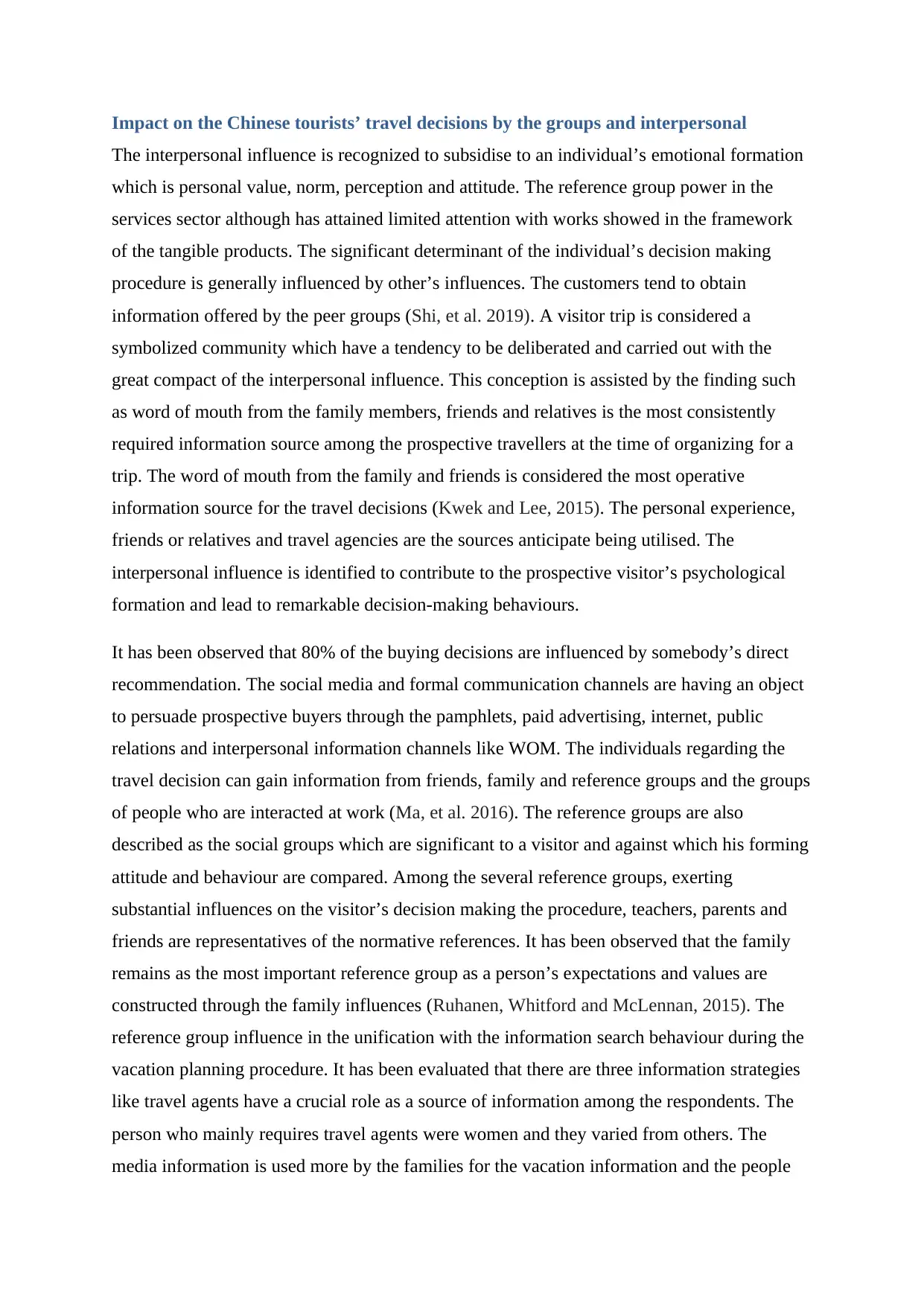
Impact on the Chinese tourists’ travel decisions by the groups and interpersonal
The interpersonal influence is recognized to subsidise to an individual’s emotional formation
which is personal value, norm, perception and attitude. The reference group power in the
services sector although has attained limited attention with works showed in the framework
of the tangible products. The significant determinant of the individual’s decision making
procedure is generally influenced by other’s influences. The customers tend to obtain
information offered by the peer groups (Shi, et al. 2019). A visitor trip is considered a
symbolized community which have a tendency to be deliberated and carried out with the
great compact of the interpersonal influence. This conception is assisted by the finding such
as word of mouth from the family members, friends and relatives is the most consistently
required information source among the prospective travellers at the time of organizing for a
trip. The word of mouth from the family and friends is considered the most operative
information source for the travel decisions (Kwek and Lee, 2015). The personal experience,
friends or relatives and travel agencies are the sources anticipate being utilised. The
interpersonal influence is identified to contribute to the prospective visitor’s psychological
formation and lead to remarkable decision-making behaviours.
It has been observed that 80% of the buying decisions are influenced by somebody’s direct
recommendation. The social media and formal communication channels are having an object
to persuade prospective buyers through the pamphlets, paid advertising, internet, public
relations and interpersonal information channels like WOM. The individuals regarding the
travel decision can gain information from friends, family and reference groups and the groups
of people who are interacted at work (Ma, et al. 2016). The reference groups are also
described as the social groups which are significant to a visitor and against which his forming
attitude and behaviour are compared. Among the several reference groups, exerting
substantial influences on the visitor’s decision making the procedure, teachers, parents and
friends are representatives of the normative references. It has been observed that the family
remains as the most important reference group as a person’s expectations and values are
constructed through the family influences (Ruhanen, Whitford and McLennan, 2015). The
reference group influence in the unification with the information search behaviour during the
vacation planning procedure. It has been evaluated that there are three information strategies
like travel agents have a crucial role as a source of information among the respondents. The
person who mainly requires travel agents were women and they varied from others. The
media information is used more by the families for the vacation information and the people
The interpersonal influence is recognized to subsidise to an individual’s emotional formation
which is personal value, norm, perception and attitude. The reference group power in the
services sector although has attained limited attention with works showed in the framework
of the tangible products. The significant determinant of the individual’s decision making
procedure is generally influenced by other’s influences. The customers tend to obtain
information offered by the peer groups (Shi, et al. 2019). A visitor trip is considered a
symbolized community which have a tendency to be deliberated and carried out with the
great compact of the interpersonal influence. This conception is assisted by the finding such
as word of mouth from the family members, friends and relatives is the most consistently
required information source among the prospective travellers at the time of organizing for a
trip. The word of mouth from the family and friends is considered the most operative
information source for the travel decisions (Kwek and Lee, 2015). The personal experience,
friends or relatives and travel agencies are the sources anticipate being utilised. The
interpersonal influence is identified to contribute to the prospective visitor’s psychological
formation and lead to remarkable decision-making behaviours.
It has been observed that 80% of the buying decisions are influenced by somebody’s direct
recommendation. The social media and formal communication channels are having an object
to persuade prospective buyers through the pamphlets, paid advertising, internet, public
relations and interpersonal information channels like WOM. The individuals regarding the
travel decision can gain information from friends, family and reference groups and the groups
of people who are interacted at work (Ma, et al. 2016). The reference groups are also
described as the social groups which are significant to a visitor and against which his forming
attitude and behaviour are compared. Among the several reference groups, exerting
substantial influences on the visitor’s decision making the procedure, teachers, parents and
friends are representatives of the normative references. It has been observed that the family
remains as the most important reference group as a person’s expectations and values are
constructed through the family influences (Ruhanen, Whitford and McLennan, 2015). The
reference group influence in the unification with the information search behaviour during the
vacation planning procedure. It has been evaluated that there are three information strategies
like travel agents have a crucial role as a source of information among the respondents. The
person who mainly requires travel agents were women and they varied from others. The
media information is used more by the families for the vacation information and the people
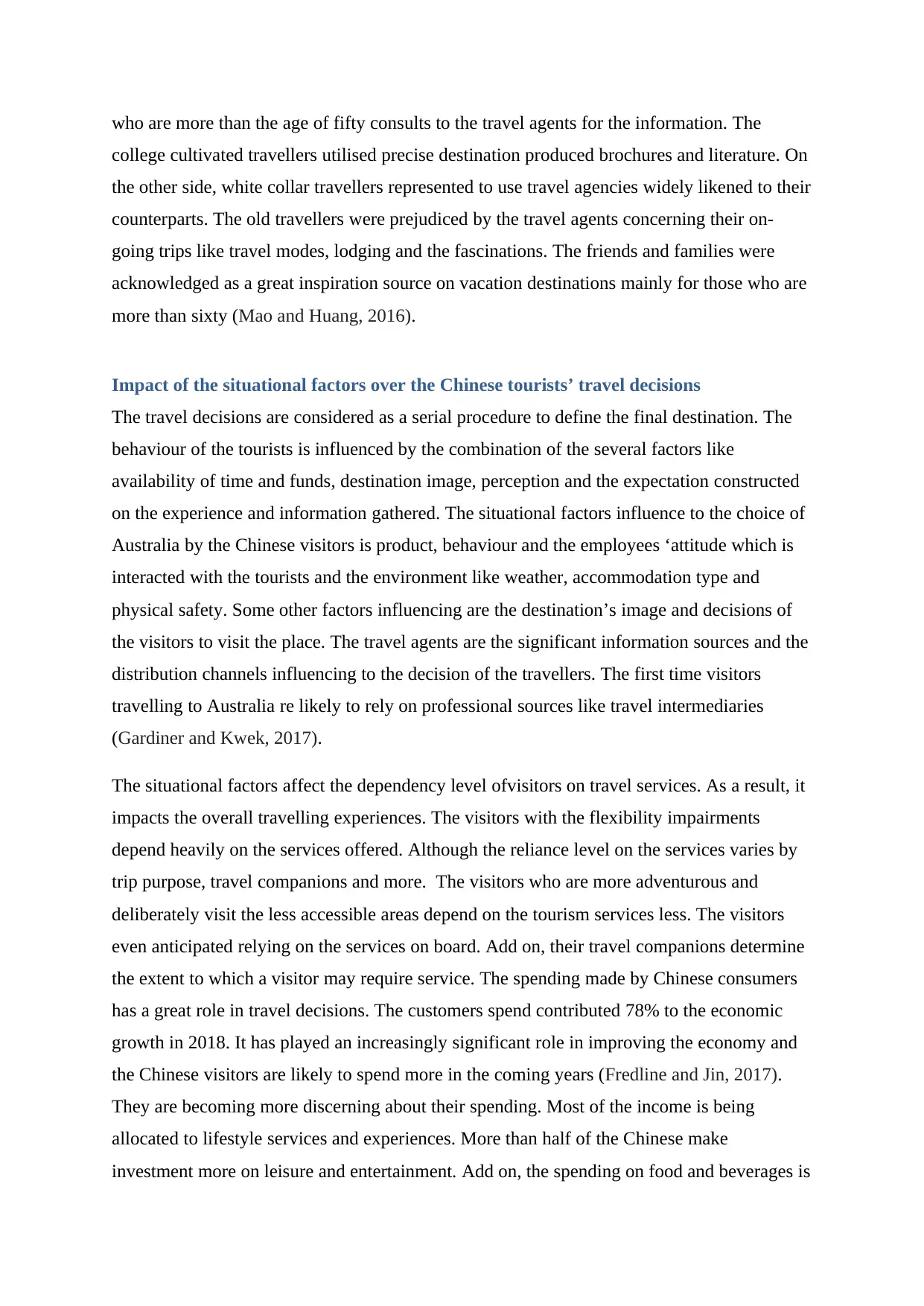
who are more than the age of fifty consults to the travel agents for the information. The
college cultivated travellers utilised precise destination produced brochures and literature. On
the other side, white collar travellers represented to use travel agencies widely likened to their
counterparts. The old travellers were prejudiced by the travel agents concerning their on-
going trips like travel modes, lodging and the fascinations. The friends and families were
acknowledged as a great inspiration source on vacation destinations mainly for those who are
more than sixty (Mao and Huang, 2016).
Impact of the situational factors over the Chinese tourists’ travel decisions
The travel decisions are considered as a serial procedure to define the final destination. The
behaviour of the tourists is influenced by the combination of the several factors like
availability of time and funds, destination image, perception and the expectation constructed
on the experience and information gathered. The situational factors influence to the choice of
Australia by the Chinese visitors is product, behaviour and the employees ‘attitude which is
interacted with the tourists and the environment like weather, accommodation type and
physical safety. Some other factors influencing are the destination’s image and decisions of
the visitors to visit the place. The travel agents are the significant information sources and the
distribution channels influencing to the decision of the travellers. The first time visitors
travelling to Australia re likely to rely on professional sources like travel intermediaries
(Gardiner and Kwek, 2017).
The situational factors affect the dependency level ofvisitors on travel services. As a result, it
impacts the overall travelling experiences. The visitors with the flexibility impairments
depend heavily on the services offered. Although the reliance level on the services varies by
trip purpose, travel companions and more. The visitors who are more adventurous and
deliberately visit the less accessible areas depend on the tourism services less. The visitors
even anticipated relying on the services on board. Add on, their travel companions determine
the extent to which a visitor may require service. The spending made by Chinese consumers
has a great role in travel decisions. The customers spend contributed 78% to the economic
growth in 2018. It has played an increasingly significant role in improving the economy and
the Chinese visitors are likely to spend more in the coming years (Fredline and Jin, 2017).
They are becoming more discerning about their spending. Most of the income is being
allocated to lifestyle services and experiences. More than half of the Chinese make
investment more on leisure and entertainment. Add on, the spending on food and beverages is
college cultivated travellers utilised precise destination produced brochures and literature. On
the other side, white collar travellers represented to use travel agencies widely likened to their
counterparts. The old travellers were prejudiced by the travel agents concerning their on-
going trips like travel modes, lodging and the fascinations. The friends and families were
acknowledged as a great inspiration source on vacation destinations mainly for those who are
more than sixty (Mao and Huang, 2016).
Impact of the situational factors over the Chinese tourists’ travel decisions
The travel decisions are considered as a serial procedure to define the final destination. The
behaviour of the tourists is influenced by the combination of the several factors like
availability of time and funds, destination image, perception and the expectation constructed
on the experience and information gathered. The situational factors influence to the choice of
Australia by the Chinese visitors is product, behaviour and the employees ‘attitude which is
interacted with the tourists and the environment like weather, accommodation type and
physical safety. Some other factors influencing are the destination’s image and decisions of
the visitors to visit the place. The travel agents are the significant information sources and the
distribution channels influencing to the decision of the travellers. The first time visitors
travelling to Australia re likely to rely on professional sources like travel intermediaries
(Gardiner and Kwek, 2017).
The situational factors affect the dependency level ofvisitors on travel services. As a result, it
impacts the overall travelling experiences. The visitors with the flexibility impairments
depend heavily on the services offered. Although the reliance level on the services varies by
trip purpose, travel companions and more. The visitors who are more adventurous and
deliberately visit the less accessible areas depend on the tourism services less. The visitors
even anticipated relying on the services on board. Add on, their travel companions determine
the extent to which a visitor may require service. The spending made by Chinese consumers
has a great role in travel decisions. The customers spend contributed 78% to the economic
growth in 2018. It has played an increasingly significant role in improving the economy and
the Chinese visitors are likely to spend more in the coming years (Fredline and Jin, 2017).
They are becoming more discerning about their spending. Most of the income is being
allocated to lifestyle services and experiences. More than half of the Chinese make
investment more on leisure and entertainment. Add on, the spending on food and beverages is
⊘ This is a preview!⊘
Do you want full access?
Subscribe today to unlock all pages.

Trusted by 1+ million students worldwide
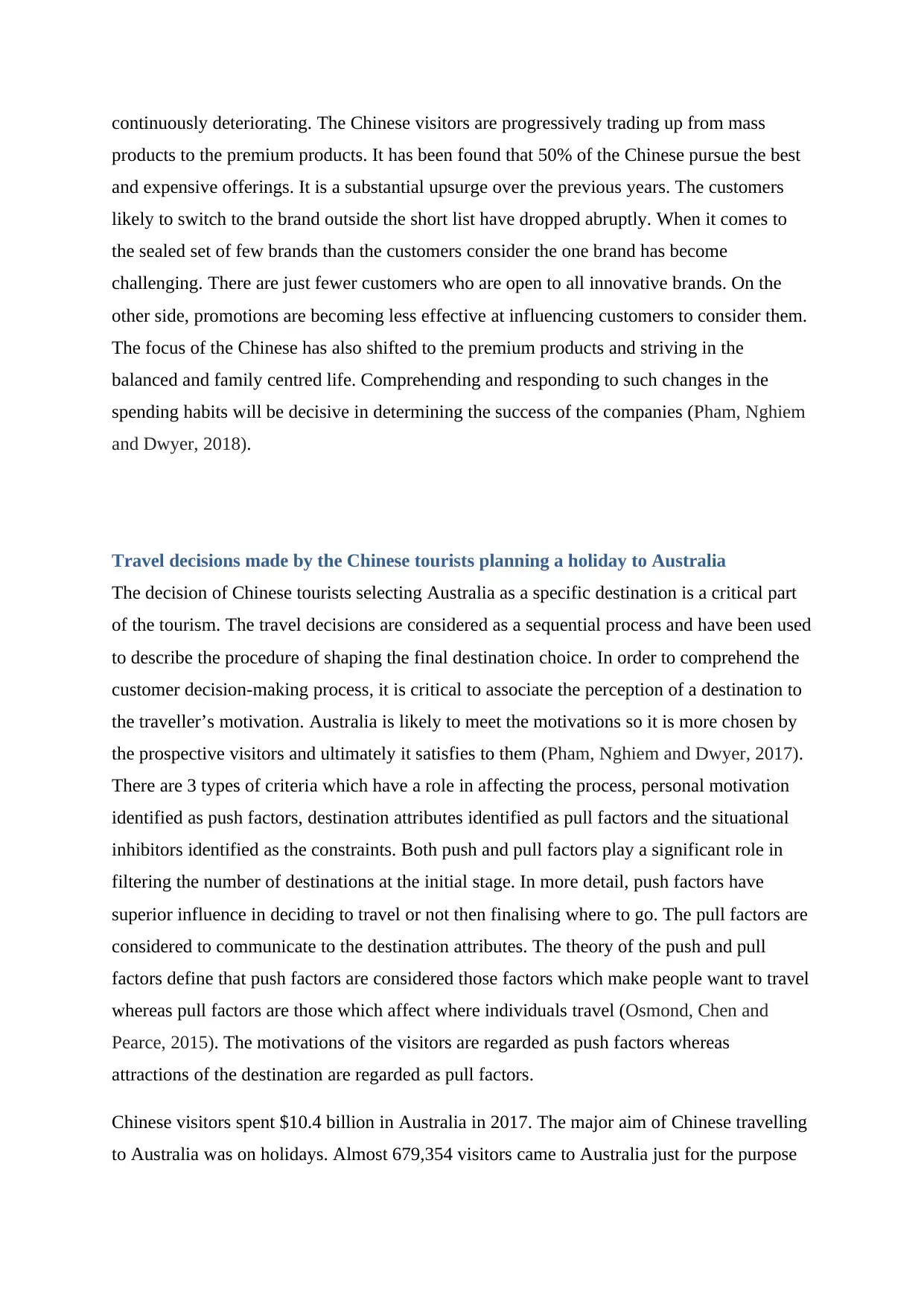
continuously deteriorating. The Chinese visitors are progressively trading up from mass
products to the premium products. It has been found that 50% of the Chinese pursue the best
and expensive offerings. It is a substantial upsurge over the previous years. The customers
likely to switch to the brand outside the short list have dropped abruptly. When it comes to
the sealed set of few brands than the customers consider the one brand has become
challenging. There are just fewer customers who are open to all innovative brands. On the
other side, promotions are becoming less effective at influencing customers to consider them.
The focus of the Chinese has also shifted to the premium products and striving in the
balanced and family centred life. Comprehending and responding to such changes in the
spending habits will be decisive in determining the success of the companies (Pham, Nghiem
and Dwyer, 2018).
Travel decisions made by the Chinese tourists planning a holiday to Australia
The decision of Chinese tourists selecting Australia as a specific destination is a critical part
of the tourism. The travel decisions are considered as a sequential process and have been used
to describe the procedure of shaping the final destination choice. In order to comprehend the
customer decision-making process, it is critical to associate the perception of a destination to
the traveller’s motivation. Australia is likely to meet the motivations so it is more chosen by
the prospective visitors and ultimately it satisfies to them (Pham, Nghiem and Dwyer, 2017).
There are 3 types of criteria which have a role in affecting the process, personal motivation
identified as push factors, destination attributes identified as pull factors and the situational
inhibitors identified as the constraints. Both push and pull factors play a significant role in
filtering the number of destinations at the initial stage. In more detail, push factors have
superior influence in deciding to travel or not then finalising where to go. The pull factors are
considered to communicate to the destination attributes. The theory of the push and pull
factors define that push factors are considered those factors which make people want to travel
whereas pull factors are those which affect where individuals travel (Osmond, Chen and
Pearce, 2015). The motivations of the visitors are regarded as push factors whereas
attractions of the destination are regarded as pull factors.
Chinese visitors spent $10.4 billion in Australia in 2017. The major aim of Chinese travelling
to Australia was on holidays. Almost 679,354 visitors came to Australia just for the purpose
products to the premium products. It has been found that 50% of the Chinese pursue the best
and expensive offerings. It is a substantial upsurge over the previous years. The customers
likely to switch to the brand outside the short list have dropped abruptly. When it comes to
the sealed set of few brands than the customers consider the one brand has become
challenging. There are just fewer customers who are open to all innovative brands. On the
other side, promotions are becoming less effective at influencing customers to consider them.
The focus of the Chinese has also shifted to the premium products and striving in the
balanced and family centred life. Comprehending and responding to such changes in the
spending habits will be decisive in determining the success of the companies (Pham, Nghiem
and Dwyer, 2018).
Travel decisions made by the Chinese tourists planning a holiday to Australia
The decision of Chinese tourists selecting Australia as a specific destination is a critical part
of the tourism. The travel decisions are considered as a sequential process and have been used
to describe the procedure of shaping the final destination choice. In order to comprehend the
customer decision-making process, it is critical to associate the perception of a destination to
the traveller’s motivation. Australia is likely to meet the motivations so it is more chosen by
the prospective visitors and ultimately it satisfies to them (Pham, Nghiem and Dwyer, 2017).
There are 3 types of criteria which have a role in affecting the process, personal motivation
identified as push factors, destination attributes identified as pull factors and the situational
inhibitors identified as the constraints. Both push and pull factors play a significant role in
filtering the number of destinations at the initial stage. In more detail, push factors have
superior influence in deciding to travel or not then finalising where to go. The pull factors are
considered to communicate to the destination attributes. The theory of the push and pull
factors define that push factors are considered those factors which make people want to travel
whereas pull factors are those which affect where individuals travel (Osmond, Chen and
Pearce, 2015). The motivations of the visitors are regarded as push factors whereas
attractions of the destination are regarded as pull factors.
Chinese visitors spent $10.4 billion in Australia in 2017. The major aim of Chinese travelling
to Australia was on holidays. Almost 679,354 visitors came to Australia just for the purpose
Paraphrase This Document
Need a fresh take? Get an instant paraphrase of this document with our AI Paraphraser
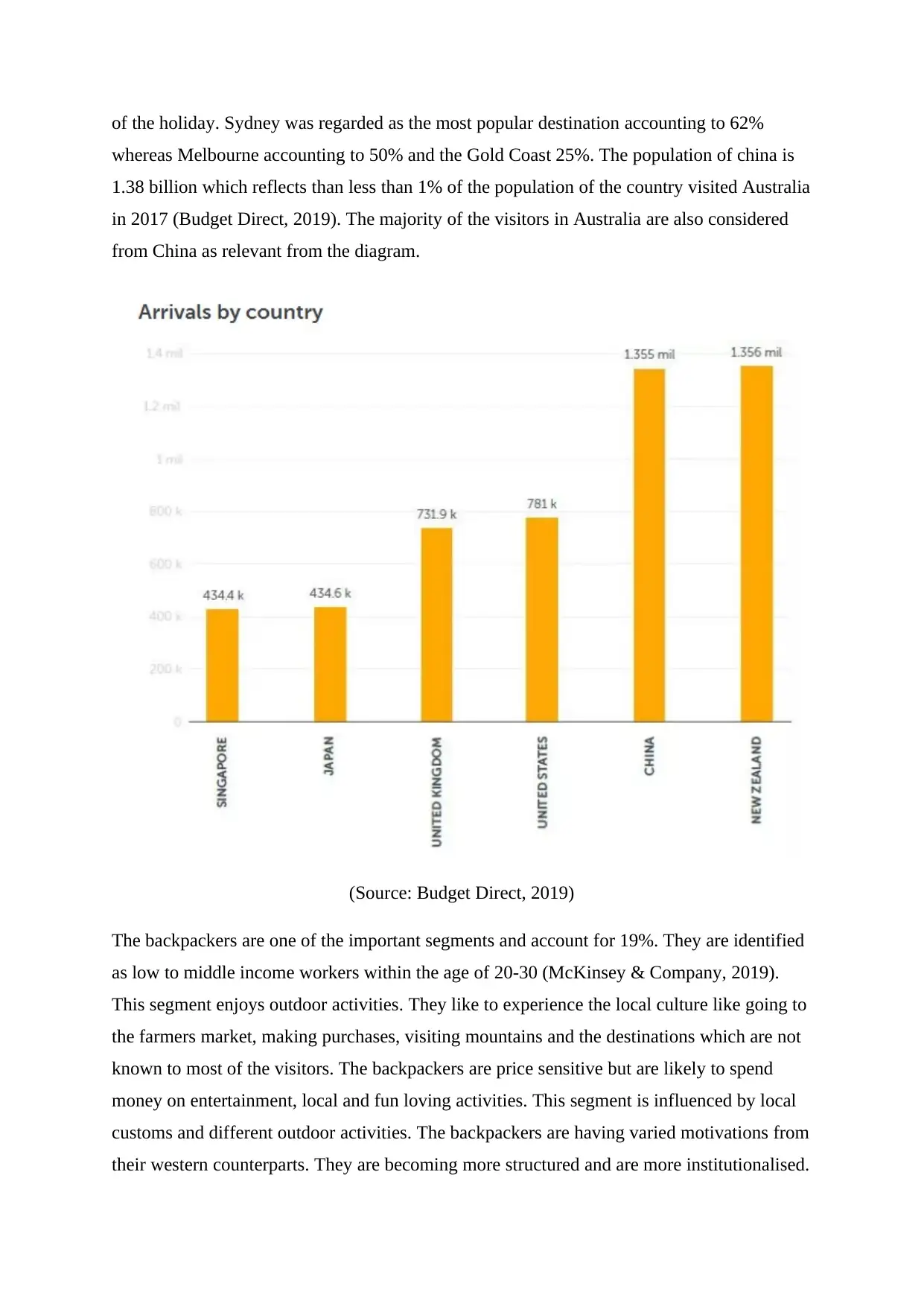
of the holiday. Sydney was regarded as the most popular destination accounting to 62%
whereas Melbourne accounting to 50% and the Gold Coast 25%. The population of china is
1.38 billion which reflects than less than 1% of the population of the country visited Australia
in 2017 (Budget Direct, 2019). The majority of the visitors in Australia are also considered
from China as relevant from the diagram.
(Source: Budget Direct, 2019)
The backpackers are one of the important segments and account for 19%. They are identified
as low to middle income workers within the age of 20-30 (McKinsey & Company, 2019).
This segment enjoys outdoor activities. They like to experience the local culture like going to
the farmers market, making purchases, visiting mountains and the destinations which are not
known to most of the visitors. The backpackers are price sensitive but are likely to spend
money on entertainment, local and fun loving activities. This segment is influenced by local
customs and different outdoor activities. The backpackers are having varied motivations from
their western counterparts. They are becoming more structured and are more institutionalised.
whereas Melbourne accounting to 50% and the Gold Coast 25%. The population of china is
1.38 billion which reflects than less than 1% of the population of the country visited Australia
in 2017 (Budget Direct, 2019). The majority of the visitors in Australia are also considered
from China as relevant from the diagram.
(Source: Budget Direct, 2019)
The backpackers are one of the important segments and account for 19%. They are identified
as low to middle income workers within the age of 20-30 (McKinsey & Company, 2019).
This segment enjoys outdoor activities. They like to experience the local culture like going to
the farmers market, making purchases, visiting mountains and the destinations which are not
known to most of the visitors. The backpackers are price sensitive but are likely to spend
money on entertainment, local and fun loving activities. This segment is influenced by local
customs and different outdoor activities. The backpackers are having varied motivations from
their western counterparts. They are becoming more structured and are more institutionalised.
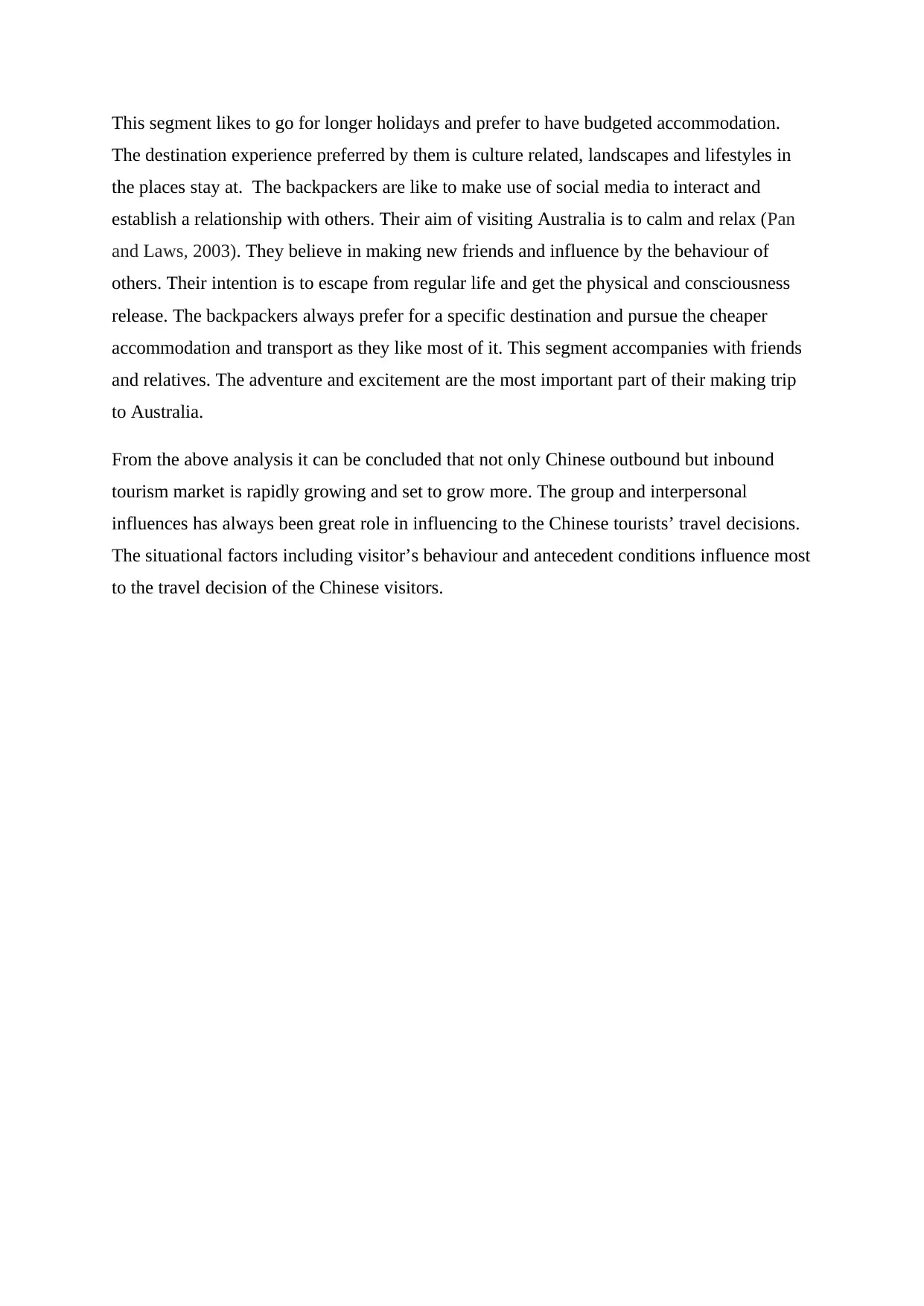
This segment likes to go for longer holidays and prefer to have budgeted accommodation.
The destination experience preferred by them is culture related, landscapes and lifestyles in
the places stay at. The backpackers are like to make use of social media to interact and
establish a relationship with others. Their aim of visiting Australia is to calm and relax (Pan
and Laws, 2003). They believe in making new friends and influence by the behaviour of
others. Their intention is to escape from regular life and get the physical and consciousness
release. The backpackers always prefer for a specific destination and pursue the cheaper
accommodation and transport as they like most of it. This segment accompanies with friends
and relatives. The adventure and excitement are the most important part of their making trip
to Australia.
From the above analysis it can be concluded that not only Chinese outbound but inbound
tourism market is rapidly growing and set to grow more. The group and interpersonal
influences has always been great role in influencing to the Chinese tourists’ travel decisions.
The situational factors including visitor’s behaviour and antecedent conditions influence most
to the travel decision of the Chinese visitors.
The destination experience preferred by them is culture related, landscapes and lifestyles in
the places stay at. The backpackers are like to make use of social media to interact and
establish a relationship with others. Their aim of visiting Australia is to calm and relax (Pan
and Laws, 2003). They believe in making new friends and influence by the behaviour of
others. Their intention is to escape from regular life and get the physical and consciousness
release. The backpackers always prefer for a specific destination and pursue the cheaper
accommodation and transport as they like most of it. This segment accompanies with friends
and relatives. The adventure and excitement are the most important part of their making trip
to Australia.
From the above analysis it can be concluded that not only Chinese outbound but inbound
tourism market is rapidly growing and set to grow more. The group and interpersonal
influences has always been great role in influencing to the Chinese tourists’ travel decisions.
The situational factors including visitor’s behaviour and antecedent conditions influence most
to the travel decision of the Chinese visitors.
⊘ This is a preview!⊘
Do you want full access?
Subscribe today to unlock all pages.

Trusted by 1+ million students worldwide
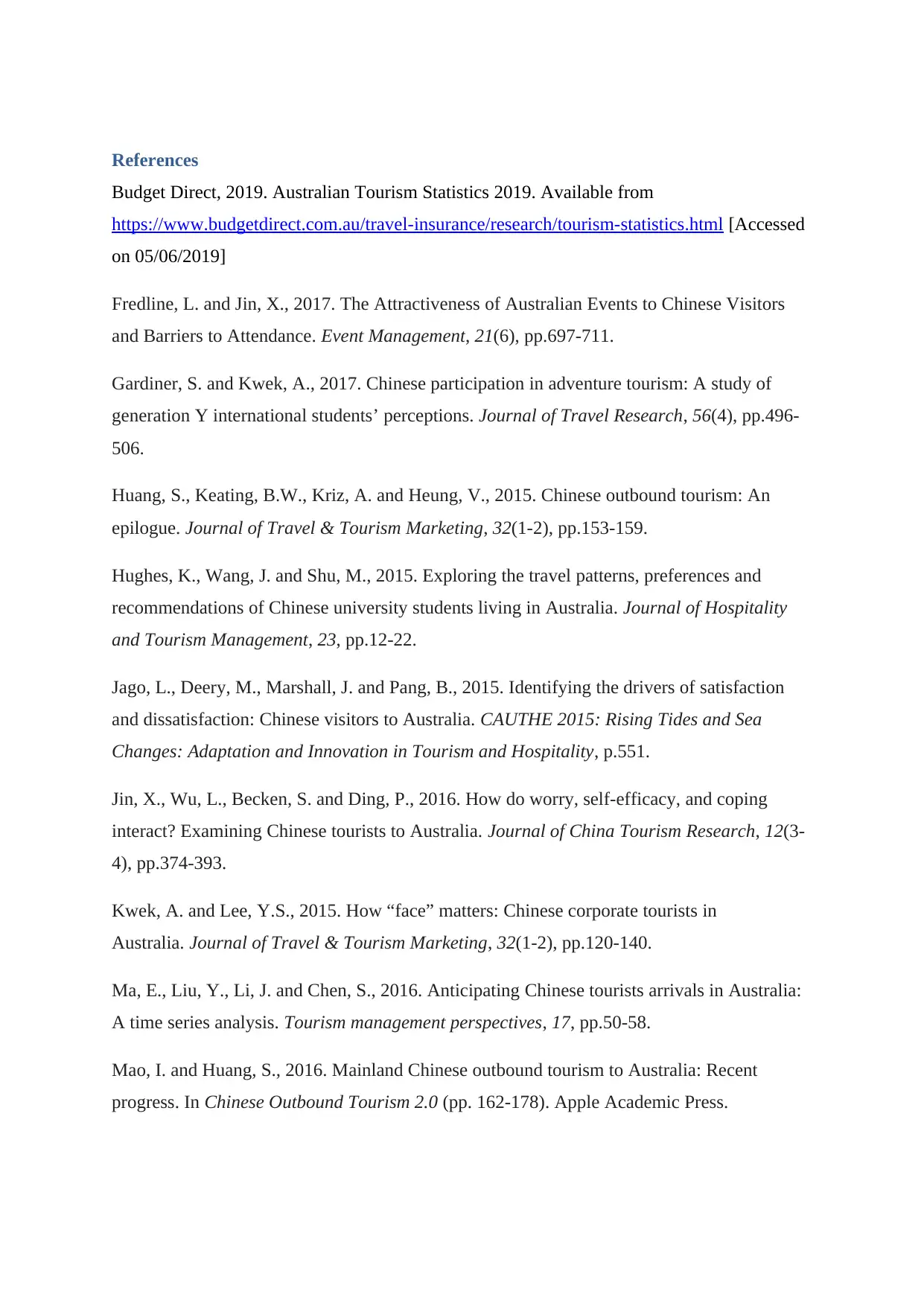
References
Budget Direct, 2019. Australian Tourism Statistics 2019. Available from
https://www.budgetdirect.com.au/travel-insurance/research/tourism-statistics.html [Accessed
on 05/06/2019]
Fredline, L. and Jin, X., 2017. The Attractiveness of Australian Events to Chinese Visitors
and Barriers to Attendance. Event Management, 21(6), pp.697-711.
Gardiner, S. and Kwek, A., 2017. Chinese participation in adventure tourism: A study of
generation Y international students’ perceptions. Journal of Travel Research, 56(4), pp.496-
506.
Huang, S., Keating, B.W., Kriz, A. and Heung, V., 2015. Chinese outbound tourism: An
epilogue. Journal of Travel & Tourism Marketing, 32(1-2), pp.153-159.
Hughes, K., Wang, J. and Shu, M., 2015. Exploring the travel patterns, preferences and
recommendations of Chinese university students living in Australia. Journal of Hospitality
and Tourism Management, 23, pp.12-22.
Jago, L., Deery, M., Marshall, J. and Pang, B., 2015. Identifying the drivers of satisfaction
and dissatisfaction: Chinese visitors to Australia. CAUTHE 2015: Rising Tides and Sea
Changes: Adaptation and Innovation in Tourism and Hospitality, p.551.
Jin, X., Wu, L., Becken, S. and Ding, P., 2016. How do worry, self-efficacy, and coping
interact? Examining Chinese tourists to Australia. Journal of China Tourism Research, 12(3-
4), pp.374-393.
Kwek, A. and Lee, Y.S., 2015. How “face” matters: Chinese corporate tourists in
Australia. Journal of Travel & Tourism Marketing, 32(1-2), pp.120-140.
Ma, E., Liu, Y., Li, J. and Chen, S., 2016. Anticipating Chinese tourists arrivals in Australia:
A time series analysis. Tourism management perspectives, 17, pp.50-58.
Mao, I. and Huang, S., 2016. Mainland Chinese outbound tourism to Australia: Recent
progress. In Chinese Outbound Tourism 2.0 (pp. 162-178). Apple Academic Press.
Budget Direct, 2019. Australian Tourism Statistics 2019. Available from
https://www.budgetdirect.com.au/travel-insurance/research/tourism-statistics.html [Accessed
on 05/06/2019]
Fredline, L. and Jin, X., 2017. The Attractiveness of Australian Events to Chinese Visitors
and Barriers to Attendance. Event Management, 21(6), pp.697-711.
Gardiner, S. and Kwek, A., 2017. Chinese participation in adventure tourism: A study of
generation Y international students’ perceptions. Journal of Travel Research, 56(4), pp.496-
506.
Huang, S., Keating, B.W., Kriz, A. and Heung, V., 2015. Chinese outbound tourism: An
epilogue. Journal of Travel & Tourism Marketing, 32(1-2), pp.153-159.
Hughes, K., Wang, J. and Shu, M., 2015. Exploring the travel patterns, preferences and
recommendations of Chinese university students living in Australia. Journal of Hospitality
and Tourism Management, 23, pp.12-22.
Jago, L., Deery, M., Marshall, J. and Pang, B., 2015. Identifying the drivers of satisfaction
and dissatisfaction: Chinese visitors to Australia. CAUTHE 2015: Rising Tides and Sea
Changes: Adaptation and Innovation in Tourism and Hospitality, p.551.
Jin, X., Wu, L., Becken, S. and Ding, P., 2016. How do worry, self-efficacy, and coping
interact? Examining Chinese tourists to Australia. Journal of China Tourism Research, 12(3-
4), pp.374-393.
Kwek, A. and Lee, Y.S., 2015. How “face” matters: Chinese corporate tourists in
Australia. Journal of Travel & Tourism Marketing, 32(1-2), pp.120-140.
Ma, E., Liu, Y., Li, J. and Chen, S., 2016. Anticipating Chinese tourists arrivals in Australia:
A time series analysis. Tourism management perspectives, 17, pp.50-58.
Mao, I. and Huang, S., 2016. Mainland Chinese outbound tourism to Australia: Recent
progress. In Chinese Outbound Tourism 2.0 (pp. 162-178). Apple Academic Press.
Paraphrase This Document
Need a fresh take? Get an instant paraphrase of this document with our AI Paraphraser
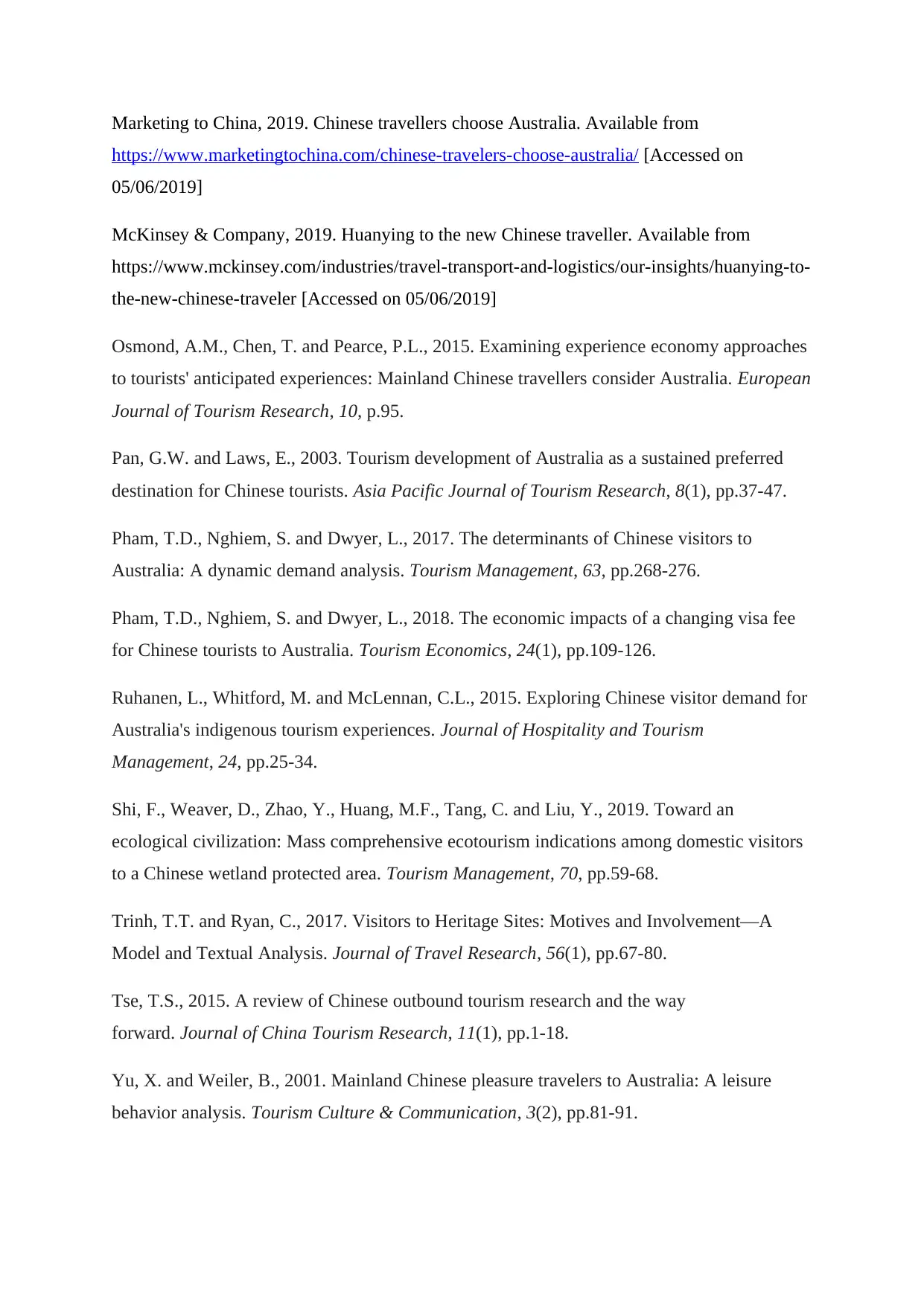
Marketing to China, 2019. Chinese travellers choose Australia. Available from
https://www.marketingtochina.com/chinese-travelers-choose-australia/ [Accessed on
05/06/2019]
McKinsey & Company, 2019. Huanying to the new Chinese traveller. Available from
https://www.mckinsey.com/industries/travel-transport-and-logistics/our-insights/huanying-to-
the-new-chinese-traveler [Accessed on 05/06/2019]
Osmond, A.M., Chen, T. and Pearce, P.L., 2015. Examining experience economy approaches
to tourists' anticipated experiences: Mainland Chinese travellers consider Australia. European
Journal of Tourism Research, 10, p.95.
Pan, G.W. and Laws, E., 2003. Tourism development of Australia as a sustained preferred
destination for Chinese tourists. Asia Pacific Journal of Tourism Research, 8(1), pp.37-47.
Pham, T.D., Nghiem, S. and Dwyer, L., 2017. The determinants of Chinese visitors to
Australia: A dynamic demand analysis. Tourism Management, 63, pp.268-276.
Pham, T.D., Nghiem, S. and Dwyer, L., 2018. The economic impacts of a changing visa fee
for Chinese tourists to Australia. Tourism Economics, 24(1), pp.109-126.
Ruhanen, L., Whitford, M. and McLennan, C.L., 2015. Exploring Chinese visitor demand for
Australia's indigenous tourism experiences. Journal of Hospitality and Tourism
Management, 24, pp.25-34.
Shi, F., Weaver, D., Zhao, Y., Huang, M.F., Tang, C. and Liu, Y., 2019. Toward an
ecological civilization: Mass comprehensive ecotourism indications among domestic visitors
to a Chinese wetland protected area. Tourism Management, 70, pp.59-68.
Trinh, T.T. and Ryan, C., 2017. Visitors to Heritage Sites: Motives and Involvement—A
Model and Textual Analysis. Journal of Travel Research, 56(1), pp.67-80.
Tse, T.S., 2015. A review of Chinese outbound tourism research and the way
forward. Journal of China Tourism Research, 11(1), pp.1-18.
Yu, X. and Weiler, B., 2001. Mainland Chinese pleasure travelers to Australia: A leisure
behavior analysis. Tourism Culture & Communication, 3(2), pp.81-91.
https://www.marketingtochina.com/chinese-travelers-choose-australia/ [Accessed on
05/06/2019]
McKinsey & Company, 2019. Huanying to the new Chinese traveller. Available from
https://www.mckinsey.com/industries/travel-transport-and-logistics/our-insights/huanying-to-
the-new-chinese-traveler [Accessed on 05/06/2019]
Osmond, A.M., Chen, T. and Pearce, P.L., 2015. Examining experience economy approaches
to tourists' anticipated experiences: Mainland Chinese travellers consider Australia. European
Journal of Tourism Research, 10, p.95.
Pan, G.W. and Laws, E., 2003. Tourism development of Australia as a sustained preferred
destination for Chinese tourists. Asia Pacific Journal of Tourism Research, 8(1), pp.37-47.
Pham, T.D., Nghiem, S. and Dwyer, L., 2017. The determinants of Chinese visitors to
Australia: A dynamic demand analysis. Tourism Management, 63, pp.268-276.
Pham, T.D., Nghiem, S. and Dwyer, L., 2018. The economic impacts of a changing visa fee
for Chinese tourists to Australia. Tourism Economics, 24(1), pp.109-126.
Ruhanen, L., Whitford, M. and McLennan, C.L., 2015. Exploring Chinese visitor demand for
Australia's indigenous tourism experiences. Journal of Hospitality and Tourism
Management, 24, pp.25-34.
Shi, F., Weaver, D., Zhao, Y., Huang, M.F., Tang, C. and Liu, Y., 2019. Toward an
ecological civilization: Mass comprehensive ecotourism indications among domestic visitors
to a Chinese wetland protected area. Tourism Management, 70, pp.59-68.
Trinh, T.T. and Ryan, C., 2017. Visitors to Heritage Sites: Motives and Involvement—A
Model and Textual Analysis. Journal of Travel Research, 56(1), pp.67-80.
Tse, T.S., 2015. A review of Chinese outbound tourism research and the way
forward. Journal of China Tourism Research, 11(1), pp.1-18.
Yu, X. and Weiler, B., 2001. Mainland Chinese pleasure travelers to Australia: A leisure
behavior analysis. Tourism Culture & Communication, 3(2), pp.81-91.

⊘ This is a preview!⊘
Do you want full access?
Subscribe today to unlock all pages.

Trusted by 1+ million students worldwide
1 out of 14
Your All-in-One AI-Powered Toolkit for Academic Success.
+13062052269
info@desklib.com
Available 24*7 on WhatsApp / Email
![[object Object]](/_next/static/media/star-bottom.7253800d.svg)
Unlock your academic potential
Copyright © 2020–2025 A2Z Services. All Rights Reserved. Developed and managed by ZUCOL.
